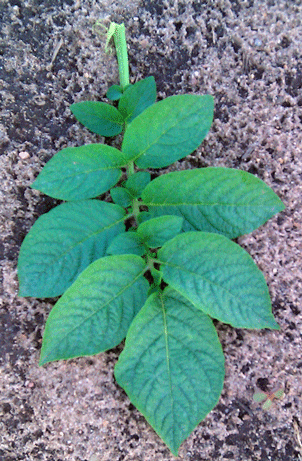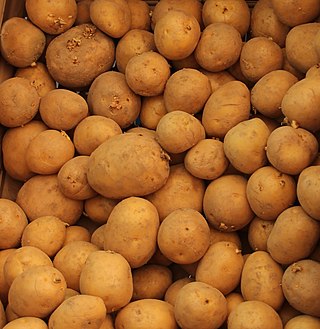Dr. Maynard Jack "Doc" Ramsay was an American entomologist noted for his efforts to track and eradicate exotic parasites carried in flowers, fruits and other cargoes arriving from overseas. He was listed in American Men of Science and Who's Who in America.

The soybean cyst nematode (SCN), Heterodera glycines, is the most devastating pest to soybean crop yields in the U.S., targeting the roots of soybean and other legume plants. When infection is severe SCNs cause stunting, yellowing, impaired canopy development, and yield loss. The symptoms caused by SCNs can go easily unrecognized by farmers—in some cases there are no warning symptoms before a loss of 40% of the yield. Due to the slight stunting and yellowing, many farmers may mistake these symptoms as environmental problems when in fact they are SCNs. Another symptom of SCNs that may affect farmers' yields is stunted roots with fewer nitrogen-fixing nodules. Due to the fact that soybean cyst nematodes can only move a few centimeters in the soil by themselves, they mostly are spread via tillage or plant transplants. This area of infection will look patchy and nonuniform making diagnosis more difficult for farmers. They can be seen in the roots of summer soybean plants if the roots are taken out very carefully and gently washed with water. The egg masses should be seen as bright white or yellow "pearls" on the roots. The later the roots are pulled the harder it will be to diagnose due to the SCNs female dying and turning a much darker color, forming a "cyst". The best way to know if a field is infected by soybean cyst nematodes is to take a soil sample to a nematologist.

Potato root nematodes or potato cyst nematodes (PCN) are 1-mm long roundworms belonging to the genus Globodera, which comprises around 12 species. They live on the roots of plants of the family Solanaceae, such as potatoes and tomatoes. PCN cause growth retardation and, at very high population densities, damage to the roots and early senescence of plants. The nematode is not indigenous to Europe but originates from the Andes. Fields are free from PCN until an introduction occurs, after which the typical patches, or hotspots, occur on the farmland. These patches can become full field infestations when unchecked. Yield reductions can average up to 60% at high population densities.

Kerr's Pink is a potato cultivar in wide production in Ireland and the United Kingdom and many other countries. Although often quoted as an "Irish potato", the cultivar was actually created by J. Henry of Cornhill, Scotland, in 1907.

Globodera pallida is a species of nematode in the family Heteroderidae. It is well known as a plant pathogen, especially of potatoes. It is "one of the most economically important plant parasitic nematodes," causing major crop losses, and is a model organism used to study the biology of cyst nematodes. Its common names include potato cyst nematode, white potato cyst nematode, pale potato cyst nematode, potato root eelworm, golden nematode, and pale cyst nematode.

Globodera rostochiensis, commonly known as the golden nematode, golden eelworm or yellow potato cyst nematode, is a plant pathogenic nematode. It is a pest of plants in the family Solanaceae, primarily infesting potatoes and tomatoes, as well as a variety of other root crops.

King Edward is a potato cultivar grown in the UK since 1902, making it one of the oldest cultivars still grown commercially.

Cisgenesis is a product designation for a category of genetically engineered plants. A variety of classification schemes have been proposed that order genetically modified organisms based on the nature of introduced genotypical changes, rather than the process of genetic engineering.

The Atlantic potato is a mid-season potato variety for potato chip manufacturing. It was developed and released by USDA Agricultural Research Service scientists at Beltsville, Maryland, in 1978. The variety is not under plant variety protection. It is a progeny of a cross between 'Wauseon' and 'Lenape'. It is widely grown for chipping directly off the field or with short-term storage. Marketable yields are fairly high.
Superior is a white-skinned, white-fleshed, mid-season potato variety. It was released by the University of Wisconsin potato breeding program in 1962, and is not under plant variety protection. It is a progeny of a cross between 'B96-56' and 'M59.44' and was first grown in 1951. 'B96-56' was also a parent of Kennebec. Like the potato variety Atlantic, Superior is widely grown for potato chip manufacturing right off the field and marketable yields are fairly high.
MegaChip is a round white potato variety with good tuber size, and specific gravity for making potato chips.

Gala is an early-ripening firm-fleshed edible potato, for which good eating and keeping qualities are claimed. It was developed by the Groß Lüsewitz-based plant breeder Norika. In 2010, it was chosen as Thuringia's potato of the year in a public contest to which nearly 1000 consumers contributed, and in which Laura was second place.
Marcy is a late maturing white potato variety. It was originally bred in 1990 at Cornell University from a cross between the Atlantic variety and Q155-3 variety. It is mostly used for chipping but can be used for baking and boiling. It has good storability; chip color is good even after short to medium storage. Marcy has a high yielding crop.

Triple-cooked chips are a type of chips developed by the English chef Heston Blumenthal. The chips are first simmered, then cooled and drained using a sous-vide technique or by freezing; deep fried at 130 °C (266 °F) and cooled again; and finally deep-fried again at 180 °C (356 °F). The result is what Blumenthal calls "chips with a glass-like crust and a soft, fluffy centre".

Melody is a cultivar of potato.
Pike is a variety of potato bred by the Cornell and Pennsylvania Experimental Stations in March 1996. This clone originated from a cross made in 1981, between 'Allegany' and 'Atlantic potato' varieties. It is resistant to infection by golden nematode, common scab, golden necrosis, and foliage infection by Phytophthora. Pike is intended to be used agriculturally, specifically for use in potato chips.
Innovator is potato variety that is oblong in shape with a smooth skin. It is a popular potato variety in Europe and is gaining popularity in North America as a frying and baking potato. The skin of the potato variety is russeted, similar to that of a Russet Burbank potato. Innovator also has shallow eyes with a cream coloured flesh.
The Plant Breeding Institute was an agricultural research organisation in Cambridge in the United Kingdom between 1912 and 1987.
The A E Watkins Landrace Wheat Collection is a collection of heritage (landrace) varieties of wheat from around the world which are adapted to their local growing environment, the collection was collected in the 1930s and contains materials from 32 countries.
Dr. Harold Wakefield Howard OBE was a botanist, best known for breeding the Maris Piper potato variety, which was the first potato variety to be resistant to potato cyst nematodes.














